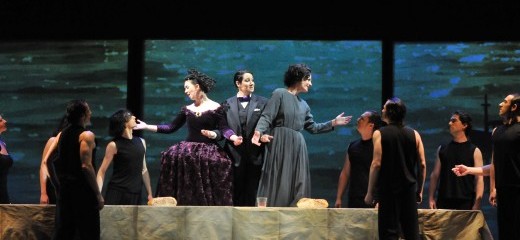
Photo: Kelly & Massa
Poetry, Oppression, and Opera
by Lynn Matluck Brooks
Opera Philadelphia’s
Ainadamar (“Fountain of Tears” in Arabic), composed by Osvaldo Golijov with libretto by David Henry Hwang, has a narrow dramatic arc. This is odd because it is about the life of dramatist and poet
Federico García Lorca and uses the conceit of a backstage view of one of Lorca’s plays to frame the opera’s story. Yet, from the start, we know that Lorca will be executed by Franco’s Falangists in the Spanish Civil War and that his friend, actress Margarita Xirgu, will mourn him for the rest of her life, blaming herself for not insisting he leave Spain with her troupe’s tour to Cuba. This tragedy, indeed, comes to pass with little suspense or surprise. The singing has a rather narrow range, too, with the three lead roles—including that of Lorca (sung by Marina Pardo)—all played by women. Xirgu is sung by Maria Hinojoso Montenegro, and Sarah Shafer plays Nuria, Xirgu’s protégé. These figures reveal little character development or emotional unfolding. Also oddly narrow is the screen space created for the video projections, by Julián de Tavira, that serve as the opera’s major scenic element but are forced to fill the frame surrounding a central live-performance space. We see the video images—sky, field, water; newsreels, explosions, fire; tears, thorns, blood—only on the sides and top of the performance frame. Much of the music and narrative are slow moving, even lugubrious.
Punctuating the opera with dynamic range, however, is the dancing of the
Antonio Gades Company. Performing choreography by Stella Arauzo, the dancers serve at times as a chorus commenting on the action; at other moments, they create what little action unfolds. Five women in deep purple dresses lead off the performance with angular stage paths, proud stances, and white-gloved arms reaching into the air—lovely movement, but without clear dramatic connection to the story. Dancers become the people of Madrid trying to survive the civil war erupting around them, the waiters in the bar where Lorca and Xirgu first meet, the Falangist soldiers who hunt Lorca down, the mourners who lament the poet’s death, the Everyman and -woman who become his followers in the Christ-like trajectory the opera pursues. The flamenco-trained dancers perform a range of emotional flavors, with long periods of soft movement emphasizing curving backs, reaching arms, falling, supporting, and embracing one another.
It is as Falangist soldiers that the dancers’
zapateo and sharp rhythmic shifts add excitement and power, projecting the terror of these hunting and killing scenes. Interestingly, the politician leading the hunt for Lorca is sung by flamenco
cantaor Alfredo Tejada, whose powerful presence and ringing voice rivet the listener’s attention. Odd that the most evil figures in the opera are expressed through traditional flamenco song and dance, for Lorca’s Andalusian roots were closely entwined with that very tradition. He was, in fact, the poet of flamenco, the playwright of
duende. As a leftist and homosexual—stances intolerable to Franco—he well understood flamenco as the voice of an oppressed minority in its Gypsy and
Mozarabic origins. Turning this tradition against him in the opera puzzles me, as is the choice to give the most attention-getting moments to his enemies, while his own story is increasingly told through heavy-handed references to crowns of thorns, Golgotha, pieta poses, and a last-supper tableau followed by heavenly ascension—an odd set of symbols for this Spanish symbolist, whose works show little relationship to Catholicism or its imagery.
The most moving emotional connection, and the scene that stayed with me from the eighty-minute, one-act opera, is between Lorca and a statue of Mariana Pineda, martyr of an earlier revolution. In an aria about the statue, which stood near his childhood home, Lorca again imagines Pineda’s heart opening up to bleed for her people and her shroud-like veil unfolding as she reaches it toward him, then lets it flutter to the ground. This scene, featuring a dancer as the statue, reveals Lorca’s heart, too, and engaged my own.
The performers—singers and dancers—were all excellent. I wished the superb Gades troupe had more opportunity to reveal the dancers’ power and virtuosity, to use the inherent drama of flamenco’s rhythms, suspensions, and expressivity to tell the story of a poet who deeply understood their art.
Ainadamar,
Opera Philadelphia, Academy of Music, Feb. 7-16, 2014.
By Lynn Matluck Brooks
February 10, 2014

